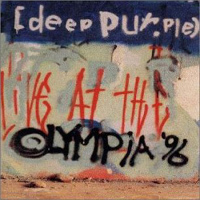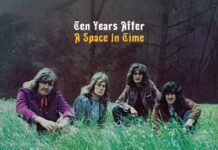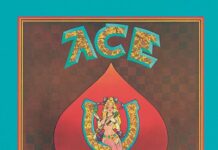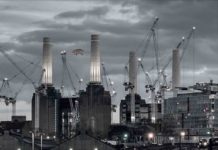Deep Purple, the quintessential hard rock quintet that first burst onto the scene in the late 60’s with “Hush,” has undergone a number of personnel changes over the years, the band’s only remaining constants being keyboardist Jon Lord and drummer Ian Paice. Each combination has met with nominal success, but the most popular mix is undoubtedly the version referred to as Mark 2. Along with Lord and Paice, this chapter in the band’s tumultuous career included co-founder Ritchie Blackmore occupying the guitar seat while vocalist Ian Gillan and bassist Roger Glover were brought in to expand the band’s growing role in the early 70’s hard rock scene. The highlight of this particular alliance was “Smoke On The Water,” perhaps one of the most renowned and influential riffs in all of rock and roll.
After three years, Gillan and Glover left the fold, but Purple continued on, enlisting newcomer David Coverdale and bassist Glenn Hughes. Persisting in the hard rock vein, the band’s success prevailed through the next couple of years. In 1975, Blackmore left to establish Rainbow, another band with a heavy rotation of personnel, too broad to cover in this article. In 1976, with Tommy Bolin on guitar, it looked as though Purple would be heading in a new, funkier direction. Unfortunately, Bolin fell victim to the perils of heroin and died just as the band was regaining their stature. Coverdale, Lord and Paice went on to form the first incarnation of Whitesnake while Hughes involved himself in a variety of different projects. By the end of 1976, Deep Purple was history.
In 1984, Mark 2 reformed and released Perfect Strangers, an extraordinary comeback album that sounded as if the group had never broken up. Unfortunately, A follow-up and ensuing live album didn’t quite measure up, and it looked as if Purple was bound to extinction once again. From all this, an interesting sidebar developed: Blackmore and Gillan were at personal odds with one another, so Joe Lynn Turner, the last singer with Rainbow, was brought in to appease the temperamental guitarist. The end result was an album — Slaves And Masters — that sounded more like Rainbow than Deep Purple, which at this point in the early 90’s, was the last thing anyone wanted to hear.
Personal reasons put aside, Mark 2 was re-assembled for one final record, The Battle Rages On. That it did: Deep Purple sounded tired, bored, finished. Blackmore has since gone on, for whatever reason, to reform Rainbow with no-name members. The remaining consituents of Deep Purple decided on a new game plan.
While several bands will replace members with unknown, but hungry musicians to replicate the hits, Deep Purple chose a different route: they went with an established original in his own right and gave him free reign. Steve Morse is best known as the de facto guitarist for the Dixie Dregs, a late 70’s fusion group that laid the groundwork for such instrumentalists as Joe Satriani and Steve Vai. In more recent years, Morse’ solo career has garnered a small, yet devoted following. At one time he was ready to drop his musical career to be a airplane pilot, but he instead signed on with Kansas and attempted to pump new life into the floundering group. Although sales of the two albums he was on were dormant, Morse’ contributions were phenomenal, to say the least. So the question in 1996 was: could he do the same for Purple?
Without major label support, the first album from this collaboration, Purpendicular, was a definite step in the right direction. Steeped knee-deep in Purpleness, Morse is still pretty much on his own, and the end result is fresh, unpredictable and rocking. Unfortunately, this unit has yet to do a major stateside tour. But they have been invading the concert halls of Europe, where Deep Purple remains a heavyweight.
In the meantime, to fill the void and demand — if either still exist — there have been a slew of Purple live albums released, none quite meeting up to the standards set by Made In Japan, the premiere Purple live album from 1973. With Live At The Olympia ’96, that standard is about to be raised.
Aside from the fact that Morse and Purple lock in like a hand in a glove, the best thing about this new live album — available only as an import — is the song selection. Along with the requisite translations of “Smoke On The Water, “Highway Star” and “Woman From The Tokyo,” there is an incredible mix of both new and classic Purple songs. Celebrating the 25th anniversary of Machine Head, the band offers up “Maybe I’m A Leo” and “Pictures of Home,” two lesser known tracks from the album, but just as enticing. The band also reaches back further and unveils some monumental versions of “Fireball,” “No One Came” and “Speed King.”
Seamlessly worked within the “oldies,” is the new stuff from Purpendicular. “Ted The Mechanic,” “Cascades: I’m Not Your Lover,” “Sometimes I Feel Like Screaming” and “Hey Cisco” fit along nicely, and really define a cutting edge attitude in the 30-year old band. Employing a horn section provides an fascinating take on some of the songs. Who would have ever thought that Deep Purple would be using horns.
All in all, if this effort is any indication, it looks as if Deep Purple is moving ahead instead of falling back on past glories. Although it is doubtful they will regain the superstar popularity of the 70s, Gillan and company can at least be assured that old nemesis Blackmore will not be finding any pots of gold over the Rainbow either. For the inclusive, it could only mean more interesting music.
~ Shawn Perry




















